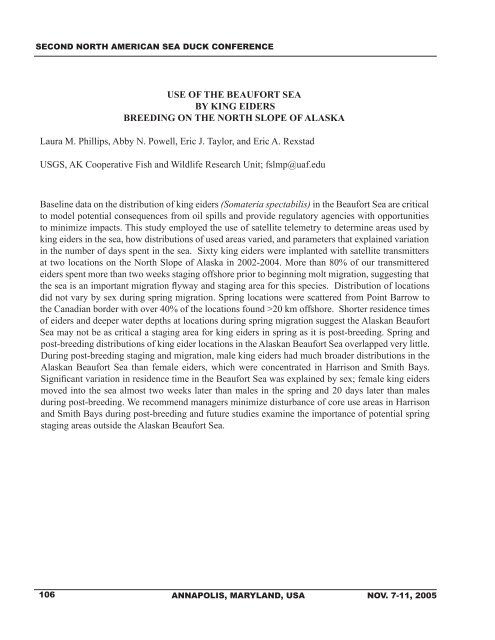Second North American Sea Duck Conference - Patuxent Wildlife ...
Second North American Sea Duck Conference - Patuxent Wildlife ...
Second North American Sea Duck Conference - Patuxent Wildlife ...
You also want an ePaper? Increase the reach of your titles
YUMPU automatically turns print PDFs into web optimized ePapers that Google loves.
SECOND NORTH AMERICAN SEA DUCK CONFERENCE<br />
USE OF THE BEAUFORT SEA<br />
BY KING EIDERS<br />
BREEDING ON THE NORTH SLOPE OF ALASKA<br />
Laura M. Phillips, Abby N. Powell, Eric J. Taylor, and Eric A. Rexstad<br />
USGS, AK Cooperative Fish and <strong>Wildlife</strong> Research Unit; fslmp@uaf.edu<br />
Baseline data on the distribution of king eiders (Somateria spectabilis) in the Beaufort <strong>Sea</strong> are critical<br />
to model potential consequences from oil spills and provide regulatory agencies with opportunities<br />
to minimize impacts. This study employed the use of satellite telemetry to determine areas used by<br />
king eiders in the sea, how distributions of used areas varied, and parameters that explained variation<br />
in the number of days spent in the sea. Sixty king eiders were implanted with satellite transmitters<br />
at two locations on the <strong>North</strong> Slope of Alaska in 2002-2004. More than 80% of our transmittered<br />
eiders spent more than two weeks staging offshore prior to beginning molt migration, suggesting that<br />
the sea is an important migration flyway and staging area for this species. Distribution of locations<br />
did not vary by sex during spring migration. Spring locations were scattered from Point Barrow to<br />
the Canadian border with over 40% of the locations found >20 km offshore. Shorter residence times<br />
of eiders and deeper water depths at locations during spring migration suggest the Alaskan Beaufort<br />
<strong>Sea</strong> may not be as critical a staging area for king eiders in spring as it is post-breeding. Spring and<br />
post-breeding distributions of king eider locations in the Alaskan Beaufort <strong>Sea</strong> overlapped very little.<br />
During post-breeding staging and migration, male king eiders had much broader distributions in the<br />
Alaskan Beaufort <strong>Sea</strong> than female eiders, which were concentrated in Harrison and Smith Bays.<br />
Significant variation in residence time in the Beaufort <strong>Sea</strong> was explained by sex; female king eiders<br />
moved into the sea almost two weeks later than males in the spring and 20 days later than males<br />
during post-breeding. We recommend managers minimize disturbance of core use areas in Harrison<br />
and Smith Bays during post-breeding and future studies examine the importance of potential spring<br />
staging areas outside the Alaskan Beaufort <strong>Sea</strong>.<br />
106 ANNAPOLIS, MARYLAND, USA NOV. 7-11, 2005












